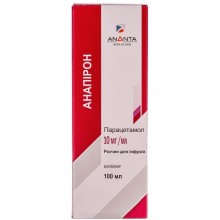



 Secure and encrypted payment processing
Secure and encrypted payment processing We ship to over 40 countries including the USA, UK, Europe, Australia and Japan
We ship to over 40 countries including the USA, UK, Europe, Australia and Japan Guaranteed refund or reship if you haven't received your order
Guaranteed refund or reship if you haven't received your orderAnapiron Infusion Solution is indicated for:
Adults:
Children: symptomatic treatment of pain and hyperthermia in postoperative patients.
Active substance: paracetamol;
100 ml of solution contains paracetamol - 1000 mg;
Excipients: mannitol (E 421) sodium phosphate, dihydrate; water for injections.
Hypersensitivity to paracetamol and other components of the drug.
Severe hepatocellular failure.
Anapiron is used to quickly relieve pain and / or hyperthermia when an exclusively intravenous route of administration is necessary.
The duration of infusion should be 15 minutes.
When using the drug for children, before the start of infusion, an excess of the drug is taken from the container and the volume of solution that corresponds to a single dose is left.
The interval between administration of the drug to adult patients with renal failure (creatinine clearance 30 ml / min) is 6 hours. The duration of treatment should not exceed 48 hours.
For adult patients with hepatocellular insufficiency, chronic alcoholism, chronic malnutrition (low supply of hepatic glutathione), dehydration, the maximum daily dose should not exceed 3 g.
A large amount of data on pregnant women indicates the absence of fetal malformations or feto / neonatal toxicity. Epidemiological studies on neurosurgery in children, in utero were exposed to paracetamol, showed inconclusive results. In case of clinical need, paracetamol can be used during pregnancy, but it should be used in a low effective dose, for the shortest possible time and at the lowest possible frequency.
Do not prescribe to children under the age of 1 year and with a body weight of less than 10 kg.
Apply to children from 1 year old with a body weight of more than 10 kg only for the symptomatic treatment of pain and hyperthermia in postoperative patients.
Does not affect.
The risk of toxic effects of the drug increases in elderly patients, children, patients with liver failure, in case of chronic alcoholism, the presence of nutritional dystrophy and in individuals with reduced enzymatic activity. In these cases, an overdose can pose a threat to the life of the patient.
Symptoms appear during the first 24 hours and are manifested by nausea, vomiting, anorexia, pallor, and abdominal pain.
Treatment: immediate hospitalization of the patient.
Probenecid halves the clearance of paracetamol by blocking its binding to glucuronic acid, so when combined with probenecid, the dose of paracetamol must be reduced.
Salicylates can increase the half-life of paracetamol from the body.
Inducers of microsomal oxidation in the liver (phenytoin, ethanol, barbiturates, rifampicin, phenylbutazone, tricyclic antidepressants) can contribute to the development of severe intoxications even with a small overdose.
Store in the original packaging out of the reach of children at a temperature not exceeding 25 ° C.
The unused drug that remains must be destroyed.
Shelf life is 3 years.